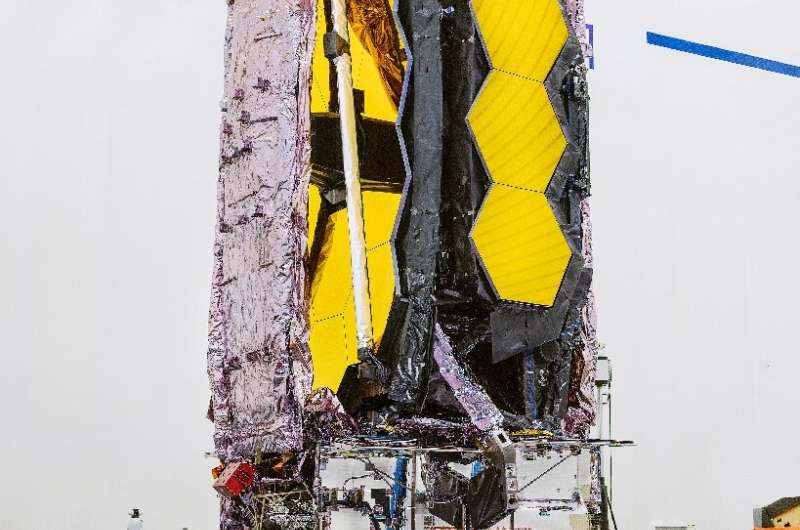
Copernical Team
Safeguarding clean water for spaceflight missions
 By all appearances, the universe beyond Earth is a vast, lonely, and sterile space. Yet, wherever humans may travel, an abundance of microbial life will follow.
In a first study of its kind, lead author Jiseon Yang at the Arizona State University Biodesign Institute, Center for Fundamental and Applied Microbiomics, and her colleagues characterized different bacterial populations isolated o
By all appearances, the universe beyond Earth is a vast, lonely, and sterile space. Yet, wherever humans may travel, an abundance of microbial life will follow.
In a first study of its kind, lead author Jiseon Yang at the Arizona State University Biodesign Institute, Center for Fundamental and Applied Microbiomics, and her colleagues characterized different bacterial populations isolated o NASA's next space telescope to launch in December

The James Webb Space Telescope, which astronomers hope will herald a new era of discovery, will launch on December 18, NASA said Wednesday.
The $10 billion observatory, which is a joint project by NASA, the European Space Agency and the Canadian Space Agency, will blast off on an Ariane 5 rocket from Spaceport in French Guiana.
Space junk traffic dangers to be tackled by first-of-its-kind research center

New ways of tackling the threat that space junk in our skies poses are being explored by University of Warwick scientists, as they pioneer new research that could help the UK fulfill its ambition to become a responsible spacefaring nation.
Scientists at a new Center for Space Domain Awareness are to focus attention on threats to the technology filling the skies above our heads in anticipation of a huge expansion in the number of satellites that provide vital services such as communications, navigation and Earth observation.
The University of Warwick is launching the Center for Space Domain Awareness to create a critical mass of research that tackles the growing threats to technology in Earth orbit. From the space junk that could collide with orbiting satellites, to the solar winds that could interfere with their electronics, the researchers at the new Center will pioneer new work to understand and characterize the near-Earth environment to support scientific, commercial, governmental and military applications.
NASA Readies James Webb Space Telescope for December Launch
 NASA plans to launch the James Webb Space Telescope into orbit Dec. 18, 2021, to serve as the premier deep space observatory for the next decade.
NASA plans to launch the James Webb Space Telescope into orbit Dec. 18, 2021, to serve as the premier deep space observatory for the next decade. New angle on reflected satnav yields sharper sea tracking

An experimental satellite navigation receiver station high atop Spain’s Mallorca island has opened up a novel view of the ever-changing face of the sea. By picking up satnav signals from the far horizon as they bounce off ocean waves, the receivers are able to measure sea surface height down to a scale of centimetres.
EC Commissioner Breton visits ESTEC
 Image:
EC Commissioner Breton visits ESTEC
Image:
EC Commissioner Breton visits ESTEC Watch live: Matthias Maurer speaks to media in Europe

ESA astronaut Matthias Maurer will soon be launched to the International Space Station for his first mission, ‘Cosmic Kiss’. Tune in to ESA Web TV from 9:00 CEST (8:00 BST) to 10:00 CEST (9:00 BST) Thursday 9 September to watch his pre-launch news conference and learn what awaits him in orbit.
Targeted launch date for Webb: 18 December 2021

ESA, NASA and Arianespace have jointly defined 18 December 2021 as the target launch date for Ariane 5 flight VA256. This third Ariane 5 launch of 2021 will fly the James Webb Space Telescope to space from Europe's Spaceport in French Guiana.
Elon Musk's Tesla Bot raises serious concerns - but probably not the ones you think
 Elon Musk announced a humanoid robot designed to help with those repetitive, boring tasks people hate doing. Musk suggested it could run to the grocery store for you, but presumably it would handle any number of tasks involving manual labor.
Predictably, social media filled with references to a string of dystopian sci-fi movies about robots where everything goes horribly wrong.
As tr
Elon Musk announced a humanoid robot designed to help with those repetitive, boring tasks people hate doing. Musk suggested it could run to the grocery store for you, but presumably it would handle any number of tasks involving manual labor.
Predictably, social media filled with references to a string of dystopian sci-fi movies about robots where everything goes horribly wrong.
As tr Adding foreign atoms to graphene does wonders to boost its properties
 Few materials have stolen the limelight like graphene. Since its discovery, graphene has become the go-to for nearly any technology out there, thanks to its exceptional properties such as high surface area, chemical stability, and high mechanical strength and elasticity.
However, despite its seemingly limitless applications, graphene's potential remains underutilized due to several factors
Few materials have stolen the limelight like graphene. Since its discovery, graphene has become the go-to for nearly any technology out there, thanks to its exceptional properties such as high surface area, chemical stability, and high mechanical strength and elasticity.
However, despite its seemingly limitless applications, graphene's potential remains underutilized due to several factors 
